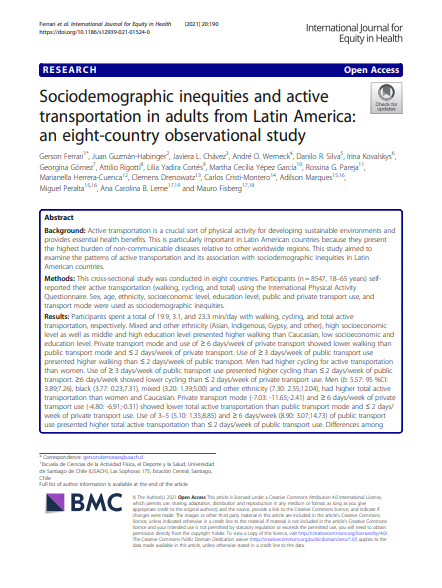Sociodemographic inequities and active transportation in adults from Latin America: an eight-country observational study

Fecha
2021-08-26Autor
Ferrari, Gerson
Guzmán-Habinger, Juan [Univ Mayor, Med Deporte & Actividad Fis, Fac Ciencias, Chile]
Chávez, Javiera L.
Werneck, Andre O.
Silva, Danilo R.
Kovalskys, Irina
Gómez, Georgina
Rigotti, Attilio
Cortés, Yadira Lilia
Yépez García, Martha Cecilia
Pareja, Rossina G.
Herrera-Cuenca, Marianella
Drenowatz, Clemens
Cristi-Montero, Carlos
Marqués, Adilson
Peralta, Miguel
Leme, Ana Carolina B.
Fisberg, Mauro
Ubicación geográfica
Notas
HERRAMIENTAS
Acceda a títulos restringidos
¿Cómo descargar?Resumen
Background: Active transportation is a crucial sort of physical activity for developing sustainable environments and provides essential health benefits. This is particularly important in Latin American countries because they present the highest burden of non-communicable diseases relative to other worldwide regions. This study aimed to examine the patterns of active transportation and its association with sociodemographic inequities in Latin American countries. Methods: This cross-sectional study was conducted in eight countries. Participants (n = 8547, 18-65 years) self-reported their active transportation (walking, cycling, and total) using the International Physical Activity Questionnaire. Sex, age, ethnicity, socioeconomic level, education level, public and private transport use, and transport mode were used as sociodemographic inequities. Results: Participants spent a total of 19.9, 3.1, and 23.3 min/day with walking, cycling, and total active transportation, respectively. Mixed and other ethnicity (Asian, Indigenous, Gypsy, and other), high socioeconomic level as well as middle and high education level presented higher walking than Caucasian, low socioeconomic and education level. Private transport mode and use of >= 6 days/week of private transport showed lower walking than public transport mode and <= 2 days/week of private transport. Use of >= 3 days/week of public transport use presented higher walking than <= 2 days/week of public transport. Men had higher cycling for active transportation than women. Use of >= 3 days/week of public transport use presented higher cycling than <= 2 days/week of public transport. >= 6 days/week showed lower cycling than <= 2 days/week of private transport use. Men (b: 5.57: 95 %CI: 3.89;7.26), black (3.77: 0.23;7.31), mixed (3.20: 1.39;5.00) and other ethnicity (7.30: 2.55;12.04), had higher total active transportation than women and Caucasian. Private transport mode (-7.03: -11.65;-2.41) and >= 6 days/week of private transport use (-4.80: -6.91;-0.31) showed lower total active transportation than public transport mode and <= 2 days/week of private transport use. Use of 3-5 (5.10: 1.35;8.85) and >= 6 days/week (8.90: 3.07;14.73) of public transport use presented higher total active transportation than <= 2 days/week of public transport use. Differences among countries were observed. Conclusions: Sociodemographic inequities are associated differently with active transportation across Latin American countries. Interventions and policies that target the promotion of active policies transportation essential to consider sociodemographic inequities.
URI
https://repositorio.umayor.cl/xmlui/handle/sibum/9126https://repositorio.ul.pt/bitstream/10451/49400/1/Sociodemographic_inequities.pdf
https://www.ncbi.nlm.nih.gov/pmc/articles/PMC8390191/pdf/12939_2021_Article_1524.pdf
https://doi.org/10.1186%2Fs12939-021-01524-0
https://kerwa.ucr.ac.cr/bitstream/handle/10669/87616/2021.08%20ELANS%20Sociodemographic%20inequities%20transportation.pdf?sequence=1
https://equityhealthj.biomedcentral.com/counter/pdf/10.1186/s12939-021-01524-0.pdf
Coleccion/es a la/s que pertenece:
Si usted es autor(a) de este documento y NO desea que su publicación tenga acceso público en este repositorio, por favor complete el formulario aquí.